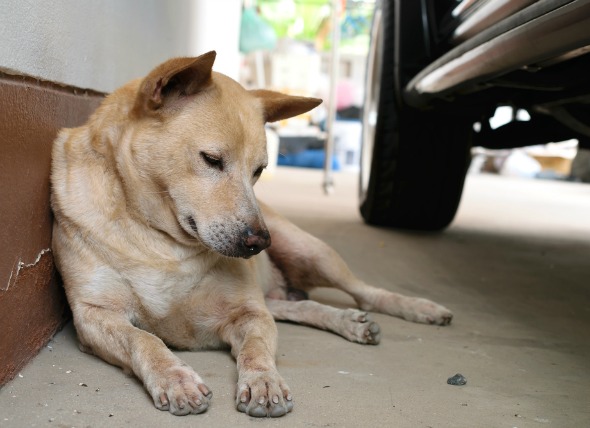

Acute lymphoblastic leukemia is a disease in which cancerous lymphoblasts (cells that are in the beginning stage of development) and prolymphocytes (cells in the intermediate stage of development) reproduce, and then circulate through the bloodstream, entering into the body's organs. These cells will also infiltrate both the inside of the bone marrow and the outside (extramedullary) of the bone marrow, displacing hematopoietic stem cells.
Hematopoietic cells are the normal, healthy precursors of red blood cells, lymphocytes, erythrocytes, platelets, eosinophils, neutrophils, macrophages and mast cells. Dogs with this disease will acquire impaired immunity, and will be inclined to contracting infections.
You will need to give your veterinarian a thorough history of your dog's health and onset of symptoms. Your veterinarian will perform a thorough physical exam on your dog, taking into account the background medical history, and possible incidents that might have precipitated this condition. A complete blood profile will be conducted, including a chemical blood profile, a complete blood count, and a urinalysis. If cancer is suspected, your doctor will also need to take bone marrow biopsies (samples) for a microscopic (cytologic) examination of the cells. If malignant cancer cells are present, the examination will show lymphoblastic infiltration of the bone marrow. Abdominal x-rays may also be taken to check for an enlarged liver and/or an enlarged spleen.
Patients can normally be treated on an outpatient basis. However, if your dog has low levels of red blood cells, platelets (the cells responsible for clotting), or other blood clotting factors, it should be hospitalized and given blood transfusions to prevent excessive bleeding. If your dog has been diagnosed with leukemia, your veterinarian will also prescribe a chemotherapeutic medicine to halt the growth of malignant cells. You will need to wear gloves when you give this medication to your dog.
If your dog is diagnosed with leukemia, you will need to keep it isolated from other animals. Your dog’s system will lack an immune response (immunocompromised) as a result of both the cancer and the therapy. In the process of destroying fast growing cancerous cells, chemotherapy will also destroy white blood cells responsible for fighting invasion, making your pet prone to infection. Even a simple cold can quickly become a fatal case of pneumonia. Red blood cells can also be affected, one possible side affect of a low red blood cell count is anemia. And blood platelets, the cells responsible for coagulation (clotting), can be affected as well. A low platelet count can result in bruising and excessive bleeding. Animals suffering from this disorder are prone to hemorrhage from lack of platelets. Your veterinarian will schedule follow-up appointments to monitor your pet’s peripheral blood count and bone marrow status. Unfortunately, the prognosis for acute lymphoblastic leukemia is grave.
 Nerve Disorder Affecting Multiple Nerves in Dogs
Peripheral Neuropathy (Polyneuropathies) in Dogs
Nerve Disorder Affecting Multiple Nerves in Dogs
Peripheral Neuropathy (Polyneuropathies) in Dogs
 Lung Cancer (Adenocarcinoma) in Dogs
Adenocarcinoma of the Lung in Dogs
Adenoca
Lung Cancer (Adenocarcinoma) in Dogs
Adenocarcinoma of the Lung in Dogs
Adenoca
 Antifreeze Poisoning in Dogs
Ethylene Glycol Poisoning in Dogs
Ethylene glycol
Antifreeze Poisoning in Dogs
Ethylene Glycol Poisoning in Dogs
Ethylene glycol
 Ingestion of Feces and Foreign Objects in Dogs
Coprophagia and Pica in Dogs
Pica is a med
Ingestion of Feces and Foreign Objects in Dogs
Coprophagia and Pica in Dogs
Pica is a med
 Colonic or Rectal Inflammation in Dogs
Colitis and Proctitis in Dogs
Histiocytic ulcerat
Colonic or Rectal Inflammation in Dogs
Colitis and Proctitis in Dogs
Histiocytic ulcerat
Copyright © 2005-2016 Pet Information All Rights Reserved
Contact us: www162date@outlook.com